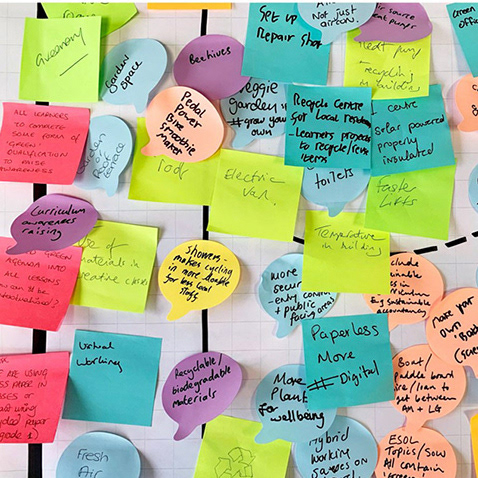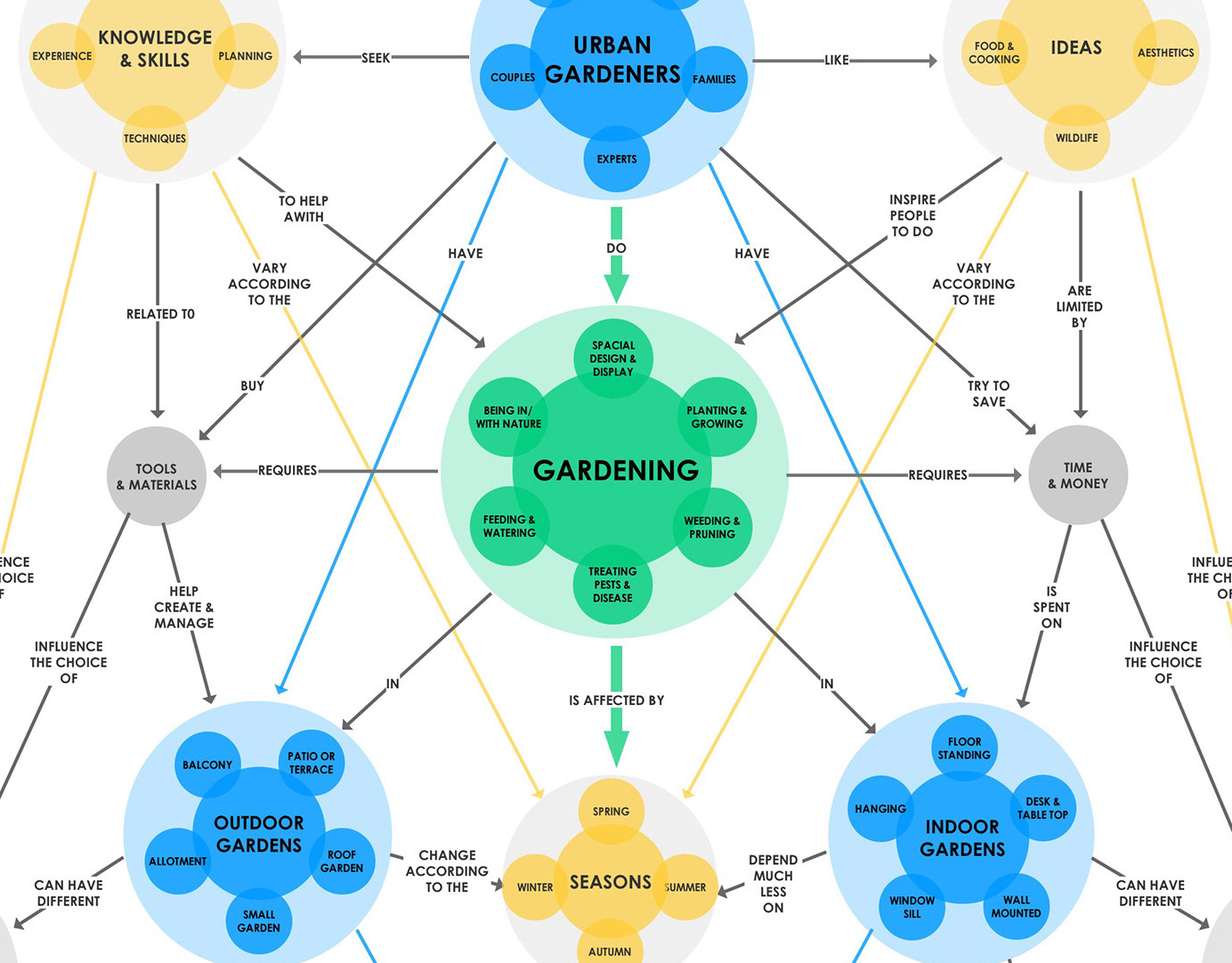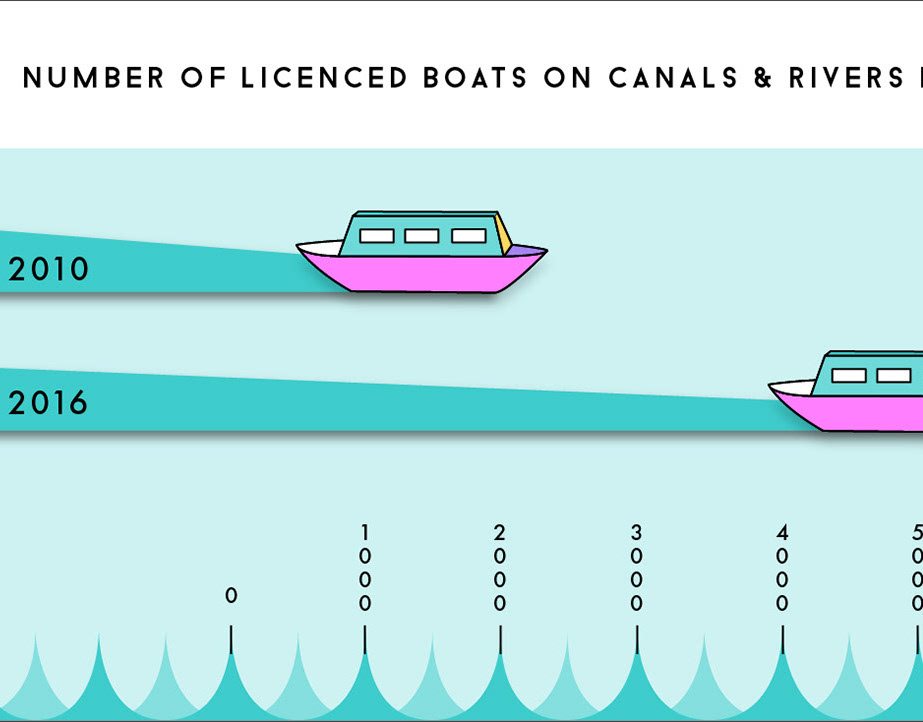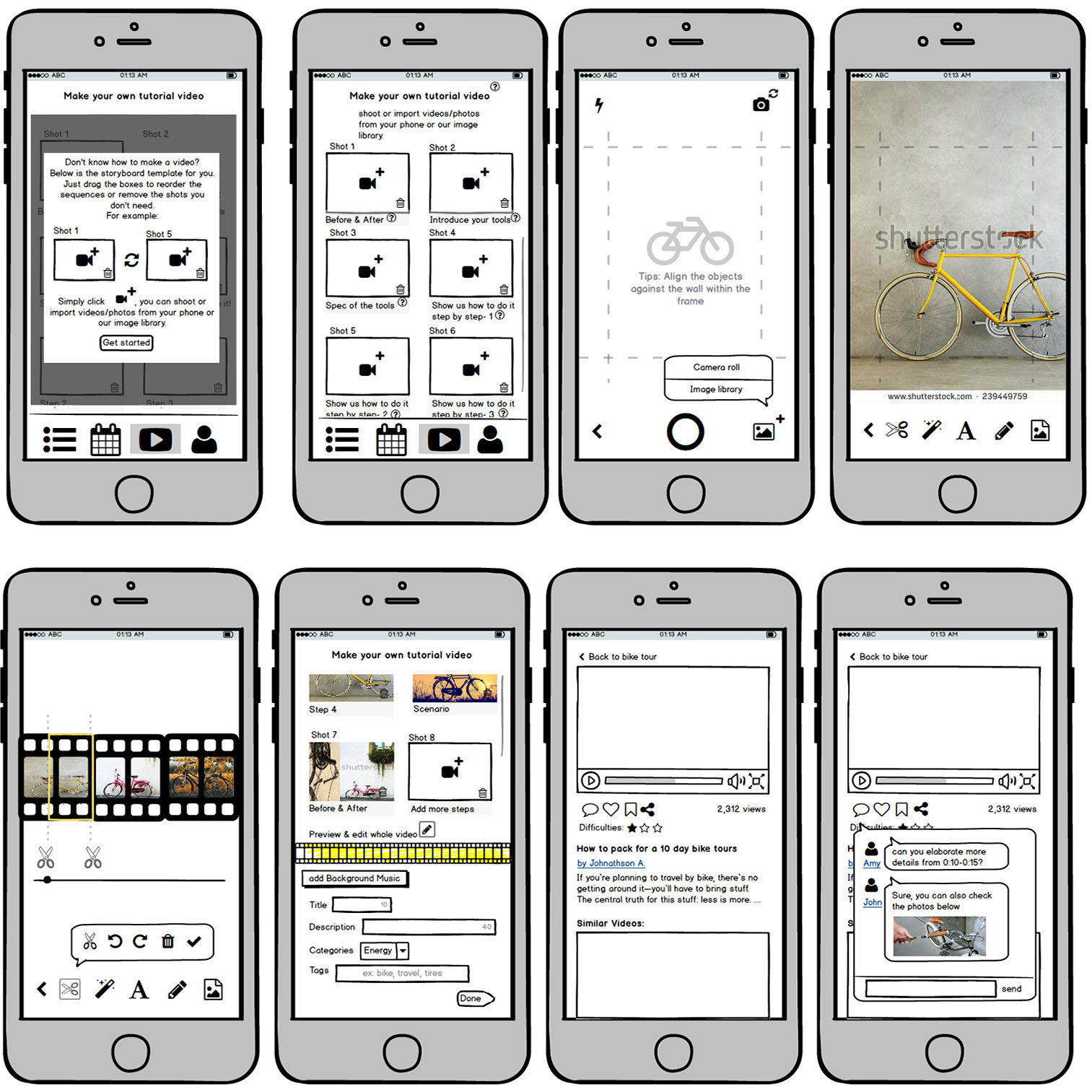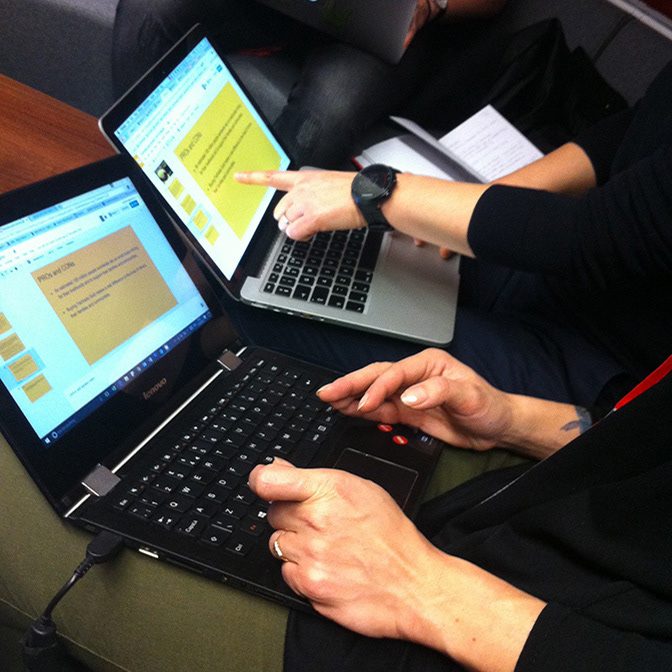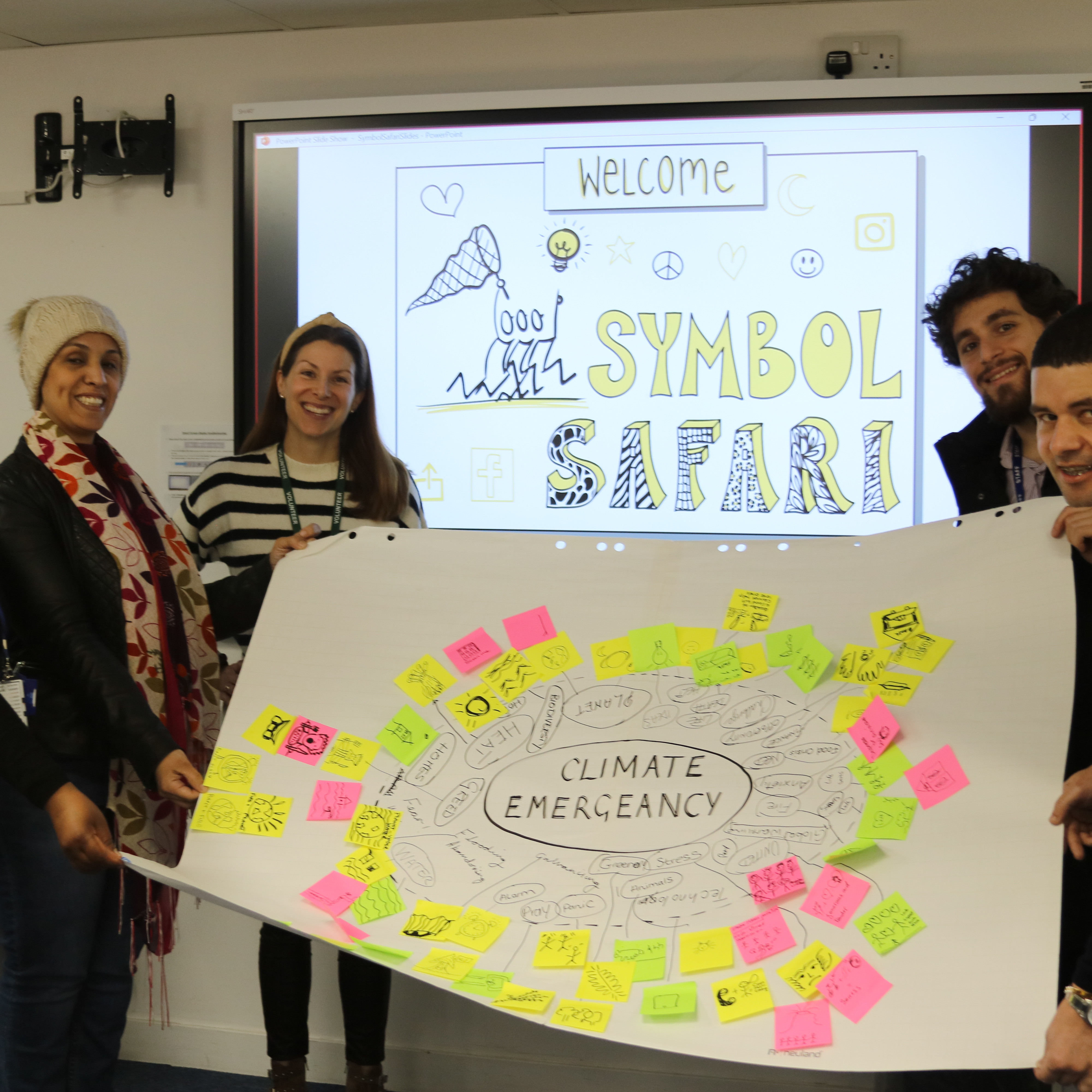Illustration by Rosie Sanders
Project Summary
The (smart) Tiny Forest is a live digital communication space that attempts to represent the secret life of trees in order to visualise and promote plant & human communication, empathy and interaction in urban spaces.
Project Aims
1) To explore a wide range of design tools, thinking and exploration techniques
2) To explore and re-imagine design spaces for the smart city to open up new or alternative spaces.
Key Challenge
To consider what is possible given a plausible combination of technology and public life in the urban realm.
Key Deliverable
The design of a device, service or infrastructure that alters the experience of the city and impacts people’s lives.
Design Team members
Rosie Sanders, Annie Strickland, Gemma Yim & Joyce Huang
*** Below is a high level summary. Please see the Tumblr Blog for the full design process including research, tools, techniques, design experiments, documentation and deliverables ***
Research
Plant Human Communication
This project aims to visualise and promote plant & human communication, empathy and interaction by studying the invisible ways that tiny urban forests and spaces are behaving and feeling in real time. As we explored plant agency and plant voices, the critical question arose: how do plants communicate?
Research unfurled a variety of answers: through colour and shape, pheromones and scent, and through underground networks of roots and fungi. As humans connect to each other through the internet, plants too, relay information and share resources through their own Wood Wide Web of fungi and tree roots (‘mycorrhiza’).
Illustration by Rosie Sanders
Parallel Networks
Mycologist Paul Stamets asserts that ‘mycelium is the neurological network of nature.’ In natural landscapes untouched by human hands, the symbiotic networks of roots and fungi (‘mycorrhiza’) make up vast and far-reaching plant infrastructures which connect entire forests.
There are amazing parallels on many levels between human and plant networks of connection, including those of the neural networks in human brains. For example, the image below on the left shows a single dopamine receptor and the one on the right shows a dense dopamine network of interconnected neurological pathways.

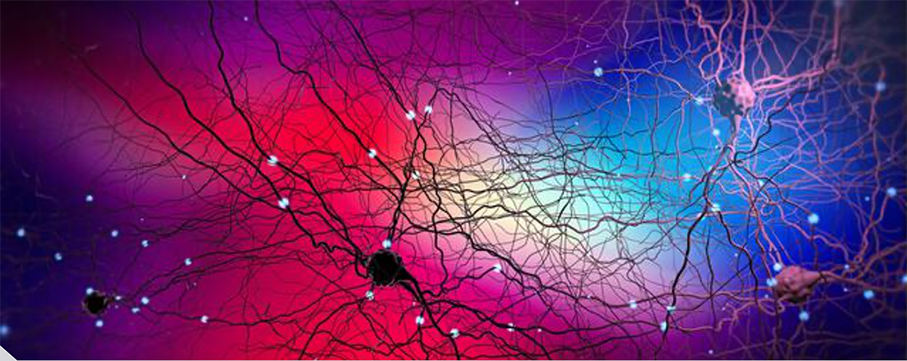
In the same way, humans have cultivated webs of virtual connectivity with similarly distributed communal structures. As the image below shows, visualisations of the Wood Wide Web and World Wide Web are strikingly similar. Source: Tai Woodville, “The Secret Life of Trees & The Science Behind Forest Bathing”
Scope
What is a Tiny Forest?
A key part of the brief is to explore and re-imagine design spaces for the smart city to open up new or alternative spaces. Earthwatch Europe defines a tiny forest as a 'dense urban forest that fights the impact of climate change'. Inspired by this initiative, but also aware of the limitations of available public space to foster dense urban forests, we have reframed this concept to include urban forests which are both dense and in contrast, also highly fragmented.
Why are Tiny Forests important?
Planting trees is one of the most effective ways of taking carbon dioxide out of the atmosphere. Our cities are increasingly vulnerable to the consequences of the climate crisis, including more severe and frequent floods and heatwaves, and loss of biodiversity.
Nature-based solutions such as Tiny Forests can help mitigate the impacts of climate change, support urban wildlife, and reconnect people with nature. Tiny Forests also provide direct links to local government and businesses’ climate and biodiversity strategies.
Where are Tiny Forests in London?
London’s green spaces are a patchy, disconnected collection of parks and leftover, in-between ‘waiting spaces’ used by people for decoration and recreation. Among these, a series of ‘tiny forests’ are scattered across the city. Some are organic spaces such as the front of Euston station are long established and almost like miniature parks. In contrast, many others are highly manicured pockets of curated greenery often added to new developments. We define tiny forests as small, often marginalised or liminal public spaces which are homes to groups of trees, such as roundabouts, plazas, and greens.
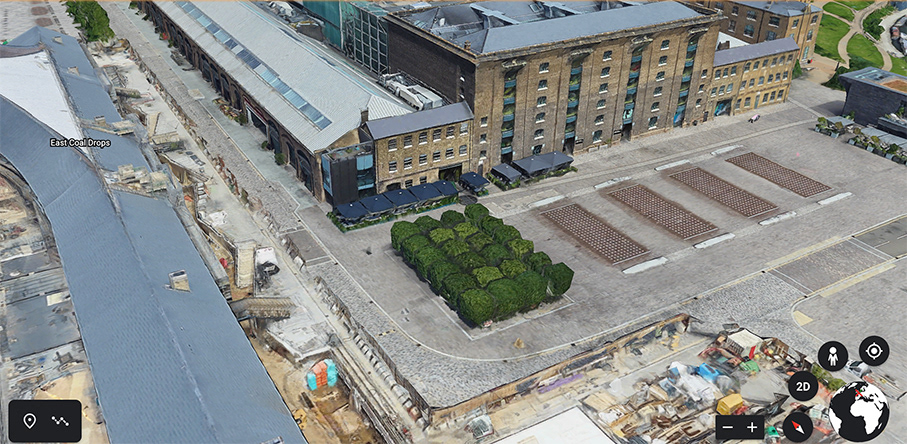
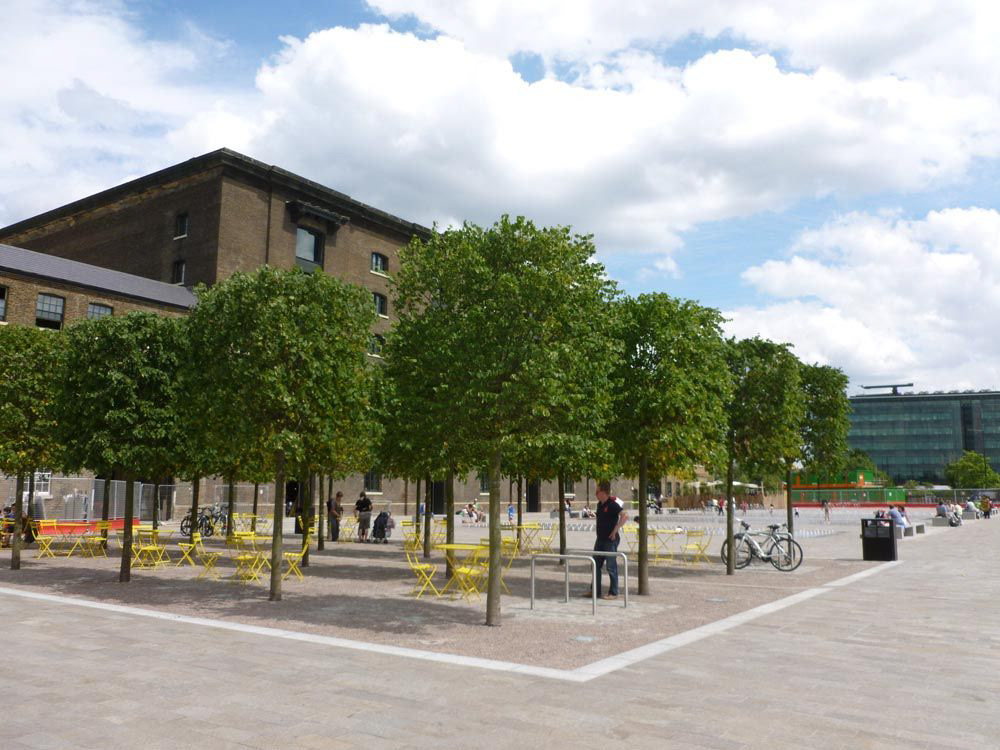
Granary Square, London N1

Archway, London N6
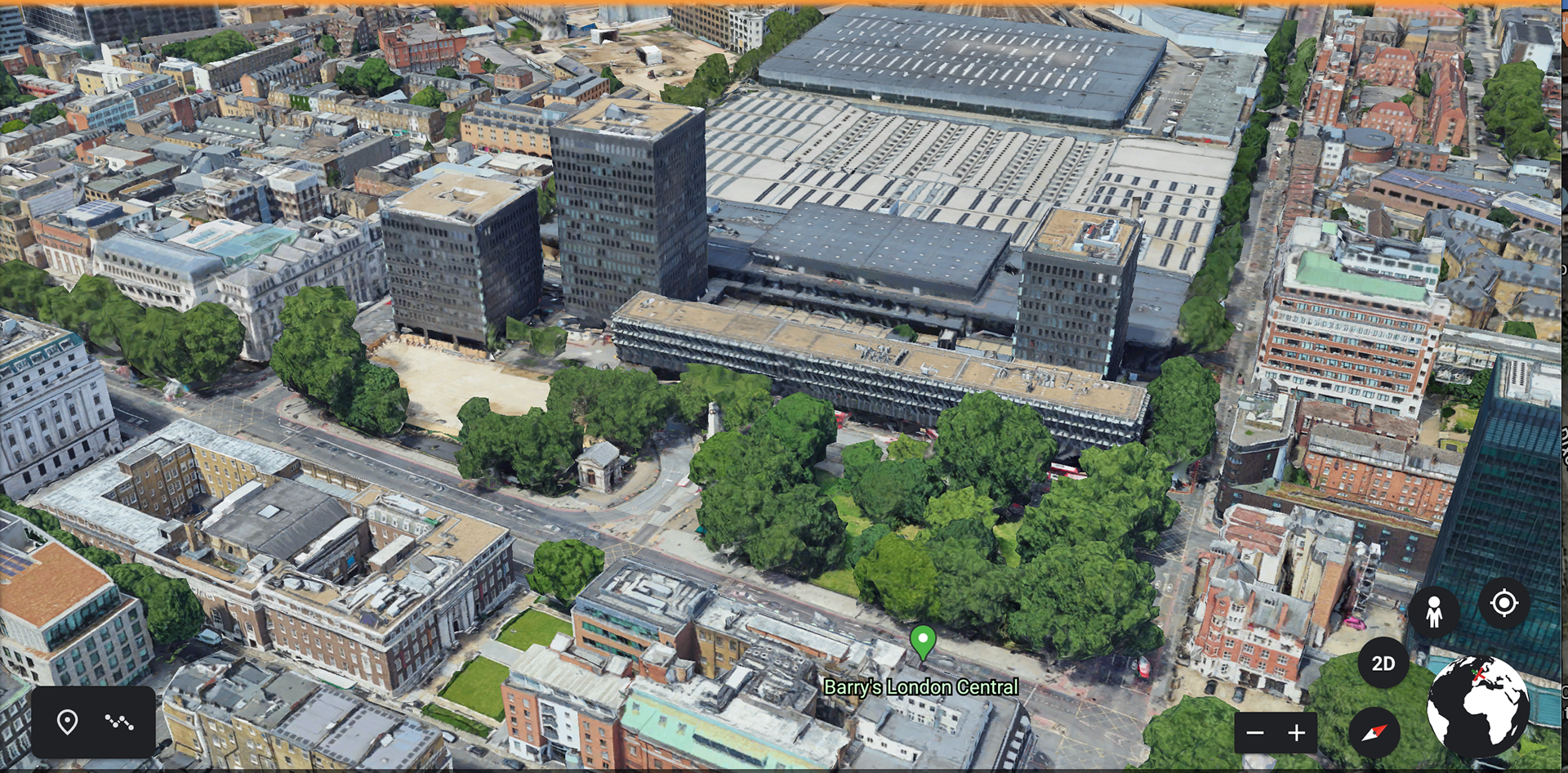
Euston Station, London
London’s green spaces are a patchy, disconnected collection of parks and leftover, in-between ‘waiting spaces’ used by people for decoration and recreation. Among these, a series of ‘tiny forests’ are scattered across the city. The two digital maps we created below serve to highlight the fragmented patchwork of green spaces throughout London. On the left, London’s parks are highlighted in green; on the right, a more zoomed in view denotes ever tinier patches of plant spaces.
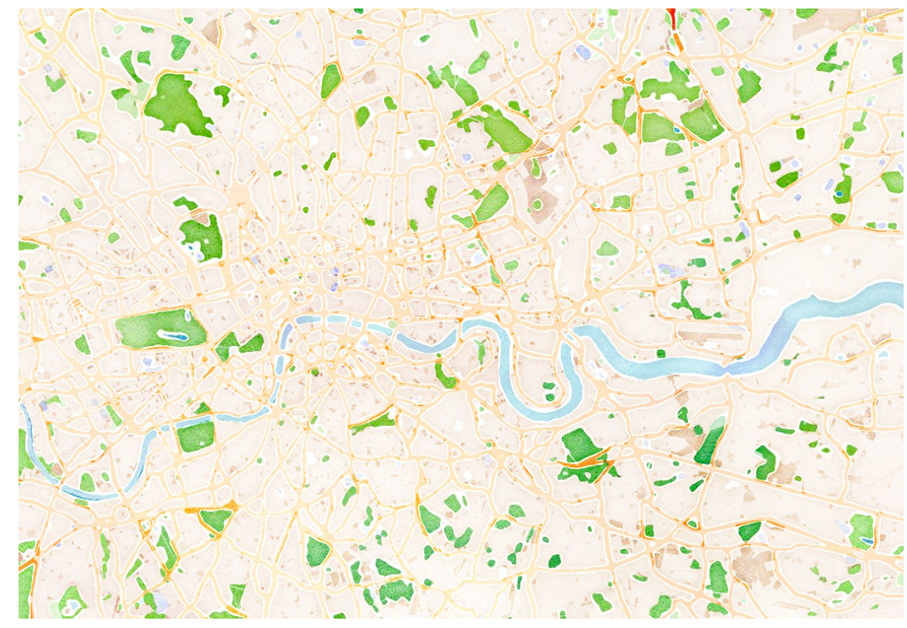
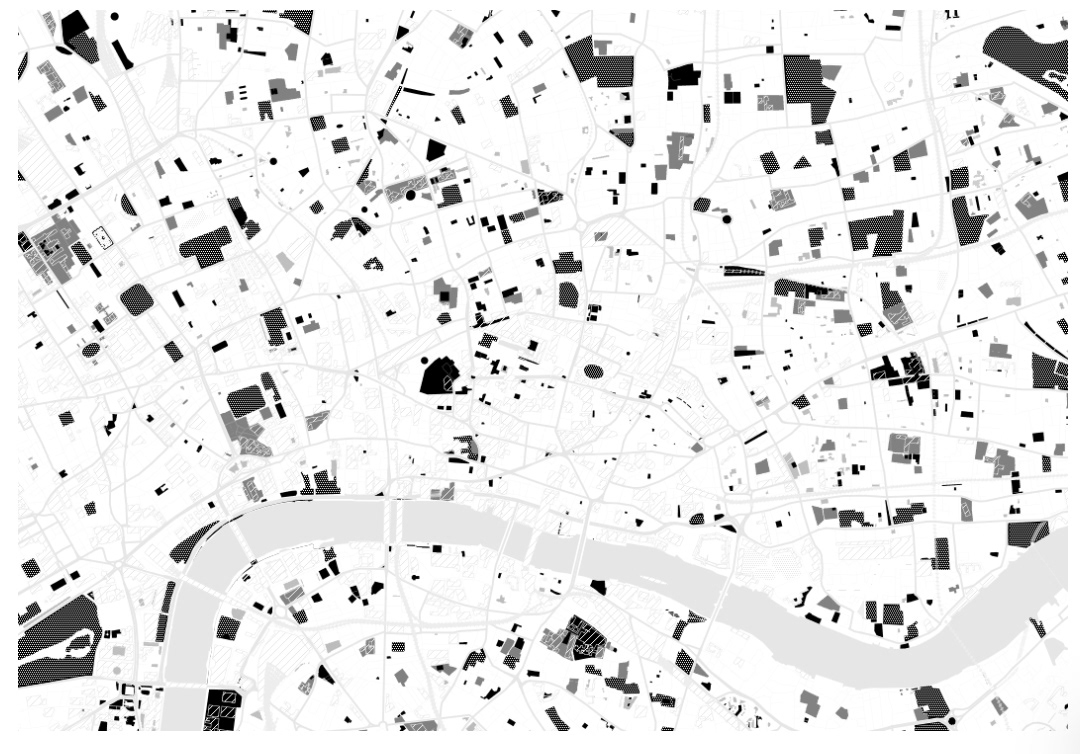
Proposal
Site-specific interactive art installations
We set out to explore what we might learn from tiny forests, to examine the flow of communication and systems of exchange in a time when humans are similarly stationary due to the Covid-19 global pandemic. The installations aim to reveal the smartness of the trees as well as the influential relationships between plants and humans.
By creating a site-specific series of exhibits, we can draw attention to the unique considerations for liminal green spaces within the city. Our installation rewards stillness, encouraging passersby to pause to “grow roots” that connect with simulations of the roots of real trees and other humans within the space.
A Juxtaposition of Tiny Forests: Two Case Studies
The proposed design juxtaposes subterranean infrastructures of two urban spaces in London's Highbury Island and Granary Square, and asks humans to alter their patterns of movement and to reflect upon the invisible interconnections and isolations that result from the ways we design, build and inhabit the city. Our site specific installations are designed to respond to both the human and ecological uniqueness and specificities of each tiny forest, the layout and features of which differ widely within cities.

Highbury Corner, London
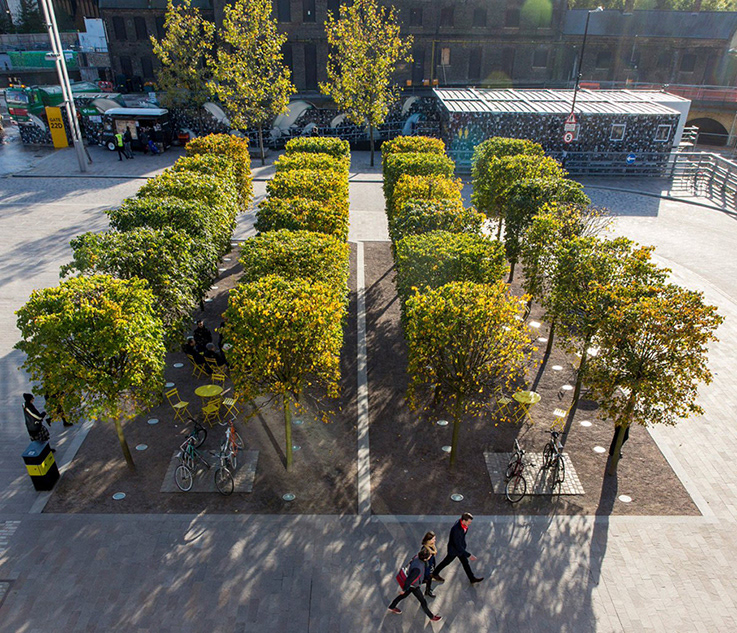
Granary Square, Kings Cross, London
Illustration by Annie Strickland
Case Study #1
Highbury Island, Islington, London N5
Is a small memorial arboretum of biodiverse mature trees who share a connected plot of land, which likely has the tree root networks that younger green spaces lack. This tiny forest is located at a hub of human networks at the busy Highbury & Islington roundabout, opposite the busy tube station.
Below is a sketch I made to visualise the Highbury Island Tiny Forest public installation. It shows the visualisation of tree roots between the trees, as well as people who sit on the pedestrianised bench area, so that there appears to be a seamless flowing out of the tree root network to the paving area that surrounds the island.
The programming of the responsive LED paving rewards the stillness of people who sit or stand for long periods of time. The premise being that roots grow between people based on time and proximity in order to make people think about the relationship of themselves to others around them. It also designed to visualise and make clear the many ways in which trees communicate with their neighbours and to show these relationships to humans who are oblivious to their supporting underground structures.
Illustration by Rosie Sanders
Digital Mock Ups for our proposed installation
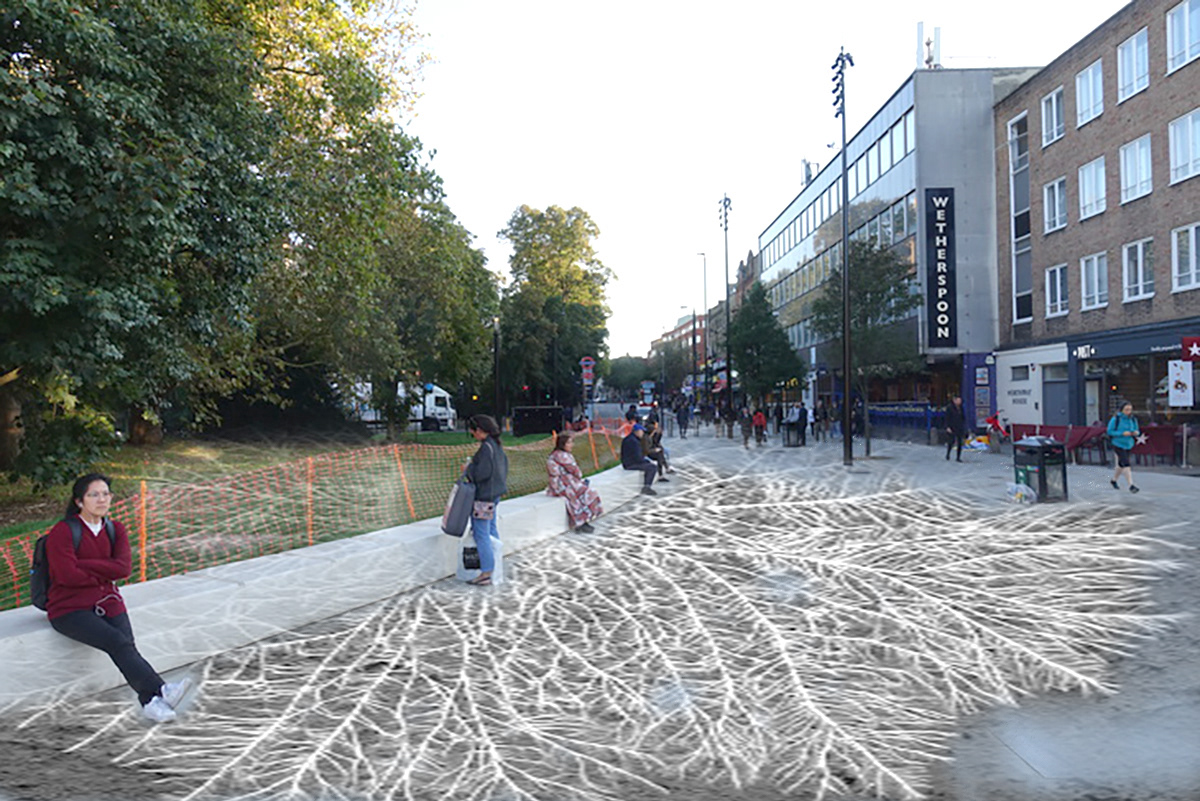
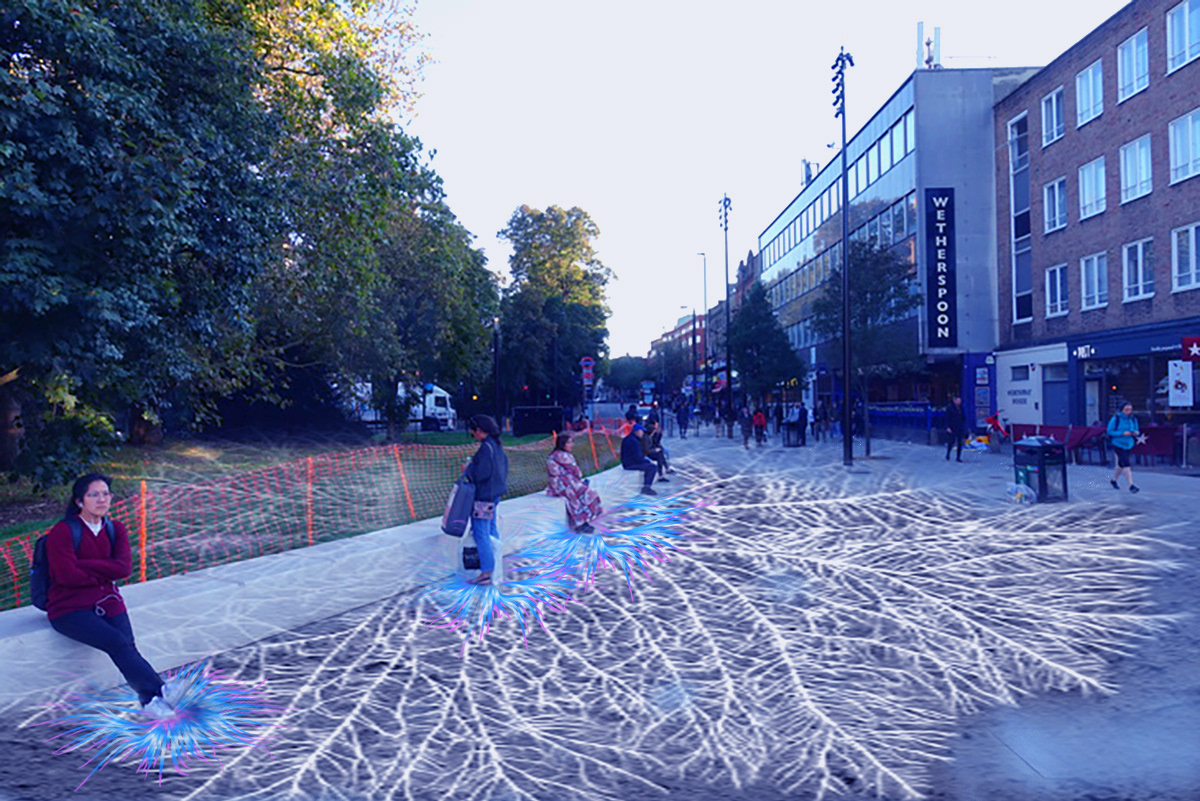
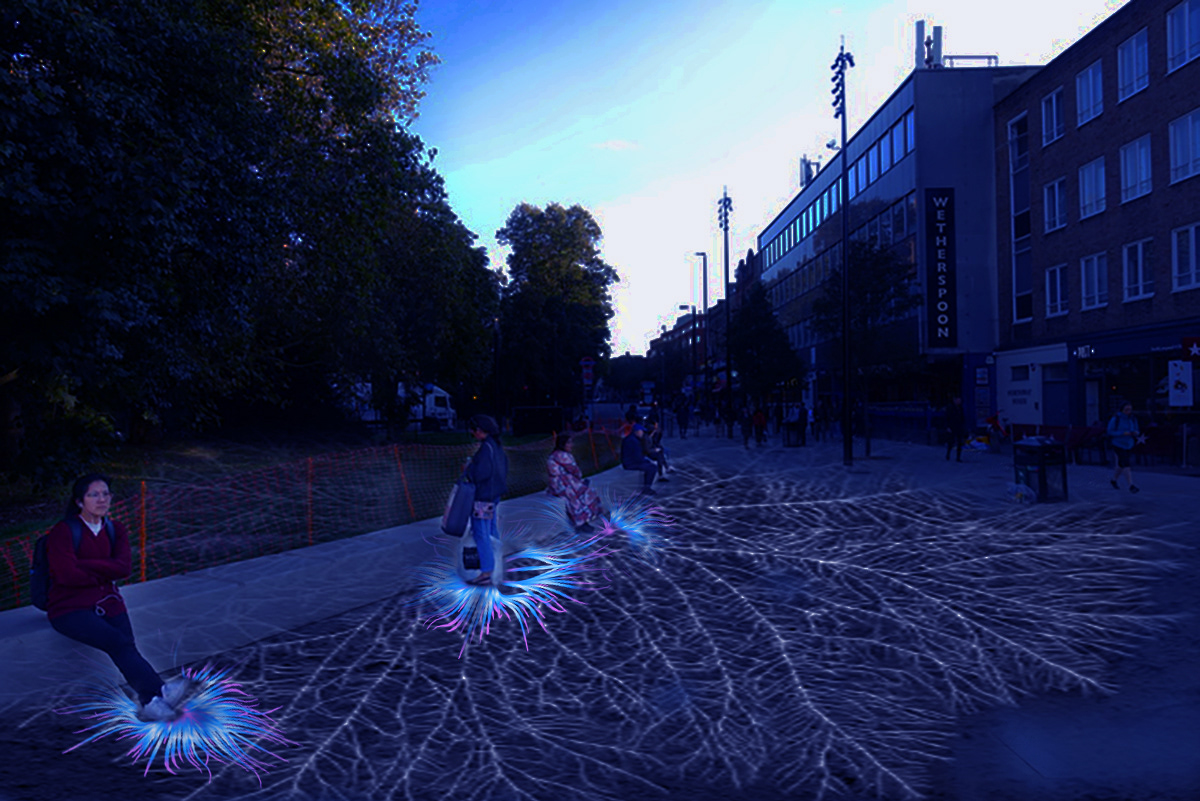
Illustrations by Rosie Sanders
The three digital mock ups above demonstrate the way in which tree roots and mycelium grow from people staying still. The longer someone stays, the more connections are visualised. This type of immersive visualisation connects people to ‘plant time’ by encouraging stillness and relationships between strangers, as well as cultivating empathy for the ‘tiny forest’ through visualising our interspecies interconnectedness.
Case Study #2
Granary Square, Kings Cross, London N1
Is home to a highly manicured bosque of trees, forced into solitude by being planted in separated tree wells that contain the root structures using lined barriers in order to prevent them from interfering with human infrastructures.
This site demonstrates a highly manicured monoculture of trees. The design and planting of trees in tree wells imposes solitude and isolation by depriving trees of connection through natural underground networks. Our design enables humans within the space to “connect” the trees by standing still, as shown in the aerial view sketch below.
It shows two humans standing still between tree wells to visualise their feet growing roots that connect the isolated tree wells. As people pause and linger within the space, their roots engage with the isolated trees’ roots forming a visual metaphor for human-plant interspecies connection.
Mock Ups for our proposed installation

Plan view of Granary Square - two humans stand still between trees to visualise their feet growing roots to connect isolated tree wells
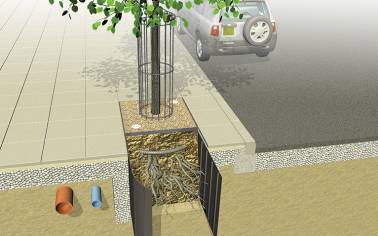
Tree Well

Granary Square Mock up of LED floor revealing subterranean tree root structures

Animation still showing LED people connecting roots
Illustrations: Top: by Annie Strickland, Bottom middle: by Rosie Sanders, Bottom Right: Joyce Huang
The first image above shows the design of a traditional tree well infrastructure that surrounds and inhibits the growth of tree roots. The second image is a digital mock up of what pedestrians would be able to see as they walk amongst the Granary Square bosque. Here, high resolution responsive LED paving would be used to show both a 3D underground perspective as well as to visualise human interaction as people move between the tree wells. This is shown in the final image which demonstrates the illumination and spreading of tree roots outwards form the feet of people who stand between the tree wells.
Smart Technology
High Resolution LED paving
High resolution LED paving such as The Vuepix Touch Screen floor deomonstrates the ways in which root visuals can displayed on high-resolution sensor-laden LED paving slabs. Responsiveness to touch and motion can incentivize stillness. Source: Still from EFTM video
Below are animation stills that illustrate how people standing on digital touch-sensitive pavement platforms catalyse ‘root growth’ around their feet.
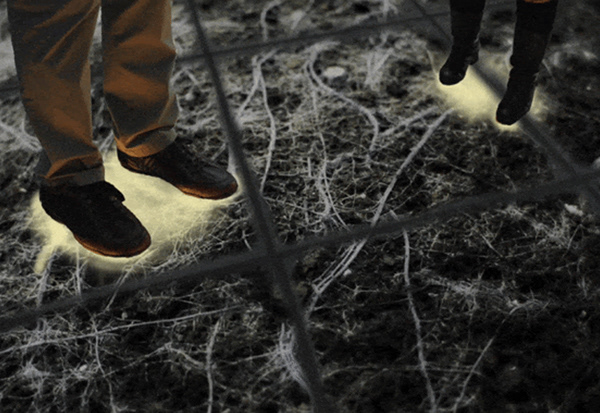
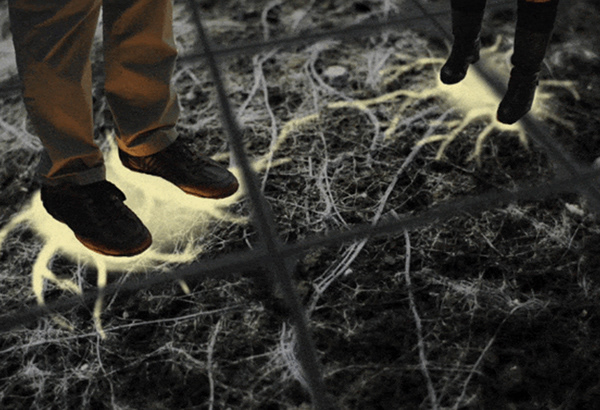
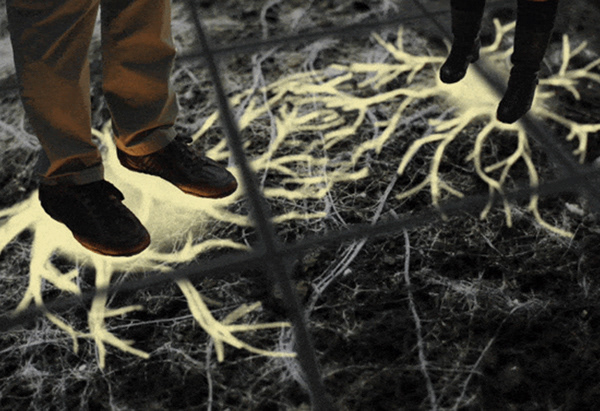
Illustrations by Joyce Huang
Making the invisible visible
The issue of representation is huge for the Tiny Forest project. Were we to just super impose an imaginary or idealised network of mycelium and myccorhiza over all Tiny Forest sites? Or, should we try to actively map the root systems underneath? For authenticity, this felt like the right decision but also in terms of mapping the current state of the trees and their health in real time, combines both aesthetic and smart city design considerations.
We had established that trees are ‘smart’ so our response needs to reflect this in a way that would have wider implications for the monitoring of tree networks in the smart city. This would enable us to map different sites and to learn more about how human activity inhibits or promotes the health of Tiny Forest in London.
Radar Technology
Our research led us to the decision to combine high resolution LED paving with radar technology in order to map urban tree networks and to show underground networks that respond to human interaction to promote affective responses. Using radar technology, digital visualisations of tree roots represent root structures as realistically as possible. The video below shows a 2D Root morphology map- aka “Virtual Excavation” that algorithmically connects the detected roots found on each scan by using non-invasive radar.
By first scanning the root networks with ground-penetrating radar technology, we can visualise the underground root connections normally invisible to humans.
Tiny Forest Design Process
Please see my dedicated Tumblr Blog for this project to examine the full design process including research, tools, techniques, design experiments, documentation and deliverables.
Critique
We are keenly aware of the risk of creating a mere passing experience and continue to consider ways to engender deep engagement and reflection. Simultaneously, we must consider how to represent plants beyond our human perspectives, give them agency, and consider how different plants may have different (and even opposing) needs.
We hope to refine this to become a tool to foster human-plant relationships and advocate for plants. Plants are more than just decoration, they are equal citizens of the city, ones that we must collaborate with for a mutually beneficial future. Ultimately, we envision a shared future, in which plant and human citizens share organic infrastructures that support symbiotic flows of communications and resources.
Please click the Tumblr Blog to see the full design process including research, tools, techniques, design experiments, documentation and deliverables.
